RTSP Streaming Server
Red5 RTSP streaming server is a reliable solution for real-time video, audio, and data delivery with sub-250 millisecond latency from IP cameras, CCTV, and IoT devices to millions of end users across the globe.
TRUSTED BY
What is RTSP Streaming?
RTSP streaming is the process of sending video and audio over a network using the Real-Time Streaming Protocol (RTSP) with latencies from sub-100ms. RTSP is widely used for IP cameras, CCTV systems, and other surveillance devices. It enables clients to play, pause, and access live feeds directly from networked cameras and devices. Learn more in our “What is RTSP?” blog.

Deliver RTSP Streaming with Red5
Live stream video, audio, and data using the Real-Time Streaming Protocol (RTSP) protocol with sub-250 ms latency to millions of viewers, even over unreliable networks, using Red5 Pro or Red5 Cloud.
Easy To Set Up and Use
Get started quickly with detailed documentation and step-by-step video tutorials that make setup and configuration simple.
Transparent and Flexible Pricing
Start streaming for free today with Red5 Cloud or Red5 Pro.
Hands-On Support
We reply to your support inquiries via email, through private dedicated channels in the Slack community for developers, and by phone.
Customers need sub-second latency that scales across many industries.
Live Auctions, Surveillance, Sports, Media, Online Gambling, Government, Interactive Shopping
Red5 RTSP Server Features
Ultra-Low Latency Streaming
Deliver video, audio, or data with sub-250 millisecond latency across various devices, from smartphones to desktop browsers.
Scalability
Automatically scale from small deployments to global audiences based on demand.
Secure Streaming
Protect streams with AES-128/256 encryption.
Recording and VOD Capabilities
Record and store your live streams effortlessly for on-demand playback.
Compositing
Mix and arrange multiple video and audio feeds in real time using server-integrated mixers, choosing Brew for native performance or CEF for web-based flexibility.
Live Metadata Support
Send real-time metadata with your streams, including speaker names, song titles, scores, and captions, to power overlays, discovery, and interactive features.
Watermarking
Create a server-side watermarked stream to brand your content.
Server-Side Ad Insertion
Integrates with our patented SSAI technology for seamless monetization.
Analytics & Monitoring
Monitor your stream health, bitrate, frame rate, connection status, and latency with intuitive dashboards.
Closed Captioning
Enhance accessibility and engagement with real-time captions, ensuring your content reaches wider audiences anywhere, anytime.
Adaptive Bitrate
ABR adapts to network conditions and resends dropped packets for stable, high-quality audio and video even on congested networks.
Firewall-Friendly Connectivity
Simplify deployment with built-in NAT traversal and automatic handshake negotiation, enabling connections through most firewalls without manual configuration.
Camera and IoT Device Compatibility
Works seamlessly with IP cameras, CCTV systems, and IoT devices such as drones and robots.
Network Resilience
Stream reliably across unpredictable public networks, mobile connections, and long-distance links using UDP-based transport optimized for real-world conditions.
How Red5 RTSP Streaming Server Works

FAQs
/
What is RTMP and how does it work?
Read our full guide “What is RTSP and and Why It Is Still Relevant in 2025” to learn about the protocol, its history, and how it delivers live video streams.
/
How to start streaming with RTSP for free?
You can start streaming with RTSP right away using our fully managed, globally distributed streaming PaaS solution, Red5 Cloud. No credit card is required to sign up, and you’ll get 50 GB of streaming free each month. If you need more flexibility, you can also start a 30-day free trial with Red5 Pro to explore custom setups.
/
Is RTSP better than RTMP?
See our detailed comparison in “RTSP vs RTMP” blog to understand the differences, advantages, and use cases of each protocol.
/
Can RTSP streams be encrypted for secure transmission?
Yes, RTSP streams can be fully encrypted for secure transmission. While traditional RTSP implementations may lack built-in encryption, Red5 Pro enhances security by supporting TLS/SSL encryption for RTSP connections and SRTP (Secure Real-time Transport Protocol) for media delivery. When converting RTSP to WebRTC, Red5 Pro implements DTLS-SRTP encryption, ensuring end-to-end security from camera to viewer. This makes Red5 Pro’s RTSP solution suitable for sensitive applications in government, healthcare, and corporate environments.
/
What is an RTSP server?
RTSP server is a media server that receives RTSP camera streams and delivers video and audio to clients such as players, monitoring systems, or applications. It manages connections, controls playback, and enables real-time viewing of IP cameras, CCTV systems, and other networked devices.
/
How to use RTSP protocol in browsers?
Read our “How to Use RTSP Protocol in Browsers” blog if you are trying to display your RTSP camera feed in a web browser. This is one of the most common challenges for developers working with IP cameras and surveillance systems.
/
What codecs does RTSP support?
RTSP supports H.264 and H.265 video codecs and AAC, AAC-LC, HE-AAC + v1 and v2, MP3, Speex, Opus, Vorbis audio codecs.
/
How many concurrent RTSP streams can Red5 Pro handle?
Red5 Pro’s architecture is designed to scale to hundreds of thousands of concurrent RTSP streams. Our cross-cloud-based autoscaling solution which we call XDN (Experience Delivery Networks) dynamically adjusts resources based on demand, allowing organizations to efficiently manage large IP camera networks without performance degradation. This scalability is particularly valuable for smart city deployments, large surveillance networks, and IoT applications where numerous devices stream simultaneously to multiple viewers.
Start Streaming with RTSP Today!
Not sure what solution would solve your streaming challenges best?
Watch our Youtube video explaining the difference between Red5 Pro and Red5 Cloud, check out the product comparison page, or reach out to us to discuss your case.







